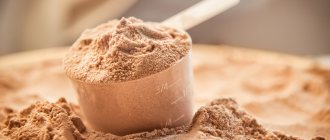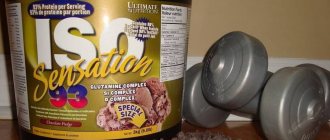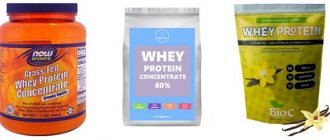Home » Mass Gain » Protein » How to Check Protein Quality
Protein
Nutritional supplements for athletes are extremely popular. This leads to the appearance of a large number of counterfeit products on the market. According to the observations of athletes, protein is most often counterfeited. A low-quality supplement is not only useless for the body, but can even cause harm. And this creates negative advertising for sports concentrates, as a result of which myths about their harmfulness appear among athletes. Therefore, you need to learn to distinguish a quality product from a fake.
How to choose quality protein?
When choosing sports nutrition, pay attention to the packaging. The label must be glued evenly and contain all the necessary information about the product - composition, expiration date, information about the manufacturer. Do not buy expired protein - it has most likely already lost its beneficial properties.
Proteins are simple proteins - organic compounds that consist of alpha amino acids linked together into a common chain by a peptide bond.
If possible, do not buy the product right away. Look at it carefully, and when you return home, find the manufacturer’s website and compare what is presented on it with what you saw in the store. Compare the labels. Very often, a fake can be recognized precisely by these inscriptions.
Pay special attention to studying the protein composition (presented on the official website) and the real one - on the product packaging. Naturally, they must match. Be sure to scan the barcode on the package. All you need is a smartphone and a special application. This will allow you to find out the country of manufacture.
Many of us, to the question “what is high-quality protein,” would most likely begin to look for the answer in our taste preferences and sensations associated with the digestion of this or that powder. In fact, the existing problems with protein quality are beyond the imagination of most of us. We bring to your attention some facts from the independent scientific laboratory ConsumerLab, which tests the quality of various types of sports nutrition (including proteins) and other supplements. You will see that the problem of the quality of sports proteins is not a myth.
By what signs can you not distinguish
First of all, the color, smell, appearance and consistency of the protein are not the characteristics by which the originality of the product should be determined. All these criteria are only conditional and are determined solely by the type, or more precisely, the composition of the protein.
1. Odor and color depend primarily on the raw materials from which a particular type of protein is produced (for example, whey and casein). This may be whey, egg albumin or soy. It is also worth considering the percentage of protein. In addition, the color of the protein may vary depending on the season. This means that, for example, in the summer months you can buy a protein with a completely different color and smell. This phenomenon can be explained simply. The fact is that protein is mainly made from milk (with the exception of soy, beef and egg). In summer, animals eat grass, which means the color of the milk will be different from that obtained at other times of the year.
2. The appearance of the grains should also not be doubted, since the protein itself is presented in the form of a fine powder and is more reminiscent of powdered milk. It must be said that all proteins are not 100% protein content; they always contain additional components in the form of carbohydrates, fats, dyes or flavors. It follows that the composition of a sports supplement can vary significantly in color, size and shape, depending on the content of these components in its composition. Therefore, if you notice some grains in the mixture, you should not immediately panic and classify it as a fake.
3. Protein consistency. It is important to take into account the fact that the protein can have either a homogeneous or lumpy shape, so this fact should not confuse you when purchasing a product.
4. Protein folding. On the one hand, you can mix the protein with boiled water and even try to cook it, but in the end you will never get the protein to fully coagulate. Why? Everything is quite simply explained by the presence of carbohydrates and fats in the protein, which due to their properties are not able to coagulate. In addition, protein behaves differently during boiling. You will not achieve the desired curds by simply pouring boiling water or hot water over the product. This result can only be achieved by boiling for 5 minutes. During this time, the protein will take the correct form of curdled clots, and the taste will resemble cottage cheese or the white of a chicken egg.
5. Smell. Many claim that they can easily identify a fake by smell, claiming that the real protein smells like burnt milk when set on fire. But again, it is worth considering the composition of the protein mixture, which also contains other additives, as we discussed above.
6. Type of packaging. Some people believe that a fake can be identified by the appearance of the packaging. In this sense, it is worth considering the fact that the same product can be produced at different factories. Thus, some brands are manufactured not only, for example, in the USA, but also under license in Europe. Naturally, the appearance of the product will differ in design and this does not mean that the high-protein product is fake. It’s another matter if the seal of the package is damaged and breaks in the label or film are visible. In this case, we recommend that you refuse such a sports supplement.
How would you answer this question “what is quality protein”?
For some, a sign of quality is a well-known brand, usually foreign (Weider, Maxler, Dymatize, etc.), but in no case domestic (PureProtein, Bellakt). Some people base their perception of quality on what their taste buds say. Others may be impressed and motivated to buy by the packaging design or the sexy naked body parts of a girl with 3M followers on Instagram, who is grateful for all her achievements to a branded jar peeking out slightly from her sports bag. On the one hand, it seems that the issue of quality is purely subjective. Ultimately, producers must use the same technologies to produce protein isolates, concentrates and hydrolysates from milk. Cows are also not very different everywhere, they eat green grass and invariably give milk of the same white color. On the other hand, common sense suggests the following arguments:
- If a cow grazes close to a highway, there is a high probability that her milk will be “enriched” with heavy metals. The same goes for plant proteins: rice, soy, and peas can be grown in soil contaminated with heavy metals and pesticides. The result is low-quality protein containing contaminants.
- If, during technological processing, even the highest quality protein is heated above a certain temperature, then denaturation of the protein itself (destruction of its molecules), complete or partial, will occur. The result is a beautifully packaged product, but virtually useless for gaining weight.
- A decrease in quality can occur due to violation of storage conditions, deliberate addition of impurities that reduce the cost of the product or enhance the anabolic effect, and many other factors.
Important! The most important thing you must understand for yourself: even the highest quality protein under certain conditions can turn into NOT high quality. And it seems that the only reliable way to check quality is laboratory analysis. A sign of quality can be the repeatability of positive laboratory tests for the same type of protein.
Even the highest quality protein can turn into poor quality under certain conditions.
In this article, using data from one of the American laboratories as an example, you will see the relevance of the above problems. Its purpose is not to scare, but to show the importance of a critical perception of the sports reality around you, especially when salesmen and marketers create it for you.
The most common protein problems
Based on the results of many years of laboratory analyzes, the American laboratory ConsumerLab indicates the following common problems with the quality of sports proteins and their causes: Lack of quality control of sports nutrition and protein in particular by government agencies In the United States, none of the government agencies, including the Food Control Administration Food and Drug Administration (FDA) does not quality test sports protein powders and drinks prior to sale. This actually means that you can sell anything under the guise of special sports nutrition. It is important to note that the lack of quality control on the part of serious institutions is typical not only for proteins, but in general for all types of sports nutrition, the number of which is growing every year: many enterprising companies and individuals are trying to take advantage of the easy opportunity to produce and sell the “newest » means for losing weight or building muscle mass “without extra effort”. Most problems associated with the quality of sports proteins can only be determined through laboratory testing. No US government agency tests the quality of sports protein powders or drinks before they are sold. Most likely, no country in the world does this. Most problems associated with the quality of sports proteins can only be determined through laboratory testing.
Proteins are the main material for the synthesis of new proteins. Taking protein allows both the protein intracellular structure and the muscle cell itself to become denser.
Inconsistency between the information on the label and the actual composition
Sometimes a simple analysis of the information on the label can help identify a low-quality product. For example: the value of the total calorie content of a product can be checked by summing the calorie content of individual nutrients (proteins, fats and carbohydrates), the mass fractions of which are indicated in our time on the packaging of absolutely all products (see example below). A gross discrepancy in values is an indirect sign of a brand with a low reputation that should not be trusted. A gross discrepancy in the information on the packaging is a sign of a brand that should not be trusted
The most common problems with the quality of sports proteins
Based on the results of many years of laboratory tests, the American laboratory ConsumerLab indicates the following common problems with the quality of sports proteins and their causes:
1 Lack of quality control of sports nutrition (and its varieties - protein, in particular) on the part of government agencies
In the United States no government agency , including the Food and Drug Administration (FDA), tests the quality of sports protein powders and drinks before sale . This actually means that you can sell anything under the guise of special sports nutrition.
It is important to note that the lack of quality control on the part of serious institutions is typical not only for proteins, but in general for all types of sports nutrition, the number of which is growing every year: many enterprising companies and individuals are trying to take advantage of the easy opportunity to produce and sell the “newest » means for losing weight or building muscle mass “without extra effort”.
Most problems associated with the quality of sports proteins can only be determined through laboratory testing .
No US government agency tests the quality of sports protein powders or drinks before they are sold. Most likely, no country in the world does this. Most problems associated with the quality of sports proteins can only be determined through laboratory testing.
We recommend : Protein bars: benefits and harm. Reviews from doctors and scientists
2 Inconsistency between the information on the label and the actual composition
Sometimes a simple analysis of the information on the label can help identify a low-quality product (see below).
For example: the value of the total calorie content of a product can be checked by summing the calorie content of individual nutrients (proteins, fats and carbohydrates), the mass fractions of which are indicated in our time on the packaging of absolutely all products (see example below).
A gross discrepancy in values is an indirect sign of a brand with a low reputation that should not be trusted.
Gross discrepancies in information on protein packaging are a sign of a brand that should not be trusted
3 Presence of hazardous and prohibited substances
One of the articles published in the Journal of Nutrition and devoted to the topic of quality of special sports protein mixtures [6], among other quality problems, lists:
- lack of some active ingredients listed on the label;
- adding undesirable or harmful substances without indicating information about their presence on the packaging;
- violation of production technology.
The article provides data from laboratory tests, in which 31% of the selected sports proteins from various brands did not pass the quality test and even contained toxic substances that could cause harm to health.
Share with us your experience of losing weight or gaining muscle mass!
For example, two products were contaminated with lead, a common occurrence for herbal-based products.
Laboratory tests often reveal the presence of prohibited and toxic substances in proteins.
Important There is only one way to avoid the risks associated with consuming low-quality proteins : purchase and use only those products whose quality has been tested in an independent laboratory.
If general words are not convincing, look at a few examples of the degradation of the beneficial properties of several types of proteins as a result of technological processing:
We recommend : Soy protein isolate: 7 facts of HARM from an exceptionally “healthy” revolutionary product
We recommend : Casein harm. Sports casein is the worst protein
4 Melamine contamination
Several years ago, one of the common quality problems with sport-specific proteins was melamine contamination .
At that time, melamine was illegally used by some manufacturers instead of protein in the production of sports proteins, since, on the one hand, it was cheaper, and on the other hand, when testing the quality of proteins using various scientific methods assessing nitrogen content, it made it possible to present the final product as “high-quality”, due to high nitrogen content.
As a result, in 2007 and 2008, numerous cases of kidney stones, kidney failure and even deaths due to the use of melamine instead of protein in pet food, milk and infant formula.
Previously, a common protein quality problem was protein contamination with melamine, which has been linked to kidney stones.
However, multiple studies of specialty protein supplements conducted by an independent laboratory in 2010 found no presence of melamine in any product.
In subsequent years, no cases of melamine contamination were identified either . Currently, testing for the presence of this substance is not carried out at all.
If you think what we do is important, support our project!
YES!
We recommend : Harmful sports nutrition: facts, reasons, recommendations
Presence of harmful and prohibited substances
One of the articles published in the Journal of Nutrition and devoted to the topic of quality of special sports protein mixtures [6], among other quality problems, lists:
- lack of some active ingredients listed on the label;
- adding undesirable or harmful substances without indicating information about their presence on the packaging;
- violation of production technology.
The article provides data from laboratory tests, in which 31% of the selected sports proteins from various brands did not pass the quality test and even contained toxic substances that could cause harm to health. For example, two products were contaminated with lead, a common occurrence for herbal-based products.
Laboratory tests often reveal the presence of prohibited and toxic substances in proteins.
Important! There is only one way to avoid the risks associated with consuming low-quality proteins: purchase and use only those products whose quality has been tested in an independent laboratory.
Melamine contamination
Several years ago, one of the common quality problems with sport-specific proteins was melamine contamination.
Melamine was illegally used by some manufacturers instead of protein in the production of sports proteins, since, on the one hand, it was cheaper, and on the other hand, when testing the quality of proteins using various scientific methods assessing the nitrogen content, it made it possible to present the final product as “quality” due to its high nitrogen content.
As a result, in 2007 and 2008, numerous cases of kidney stones, kidney failure, and even deaths were reported due to the use of melamine instead of protein in pet food, milk, and infant formula. Previously, a common protein quality problem was protein contamination with melamine, which has been linked to the formation of kidney stones. However, multiple studies of specialty protein supplements conducted by an independent laboratory in 2010 found no melamine present in any product. In subsequent years, not a single case of melamine contamination was identified. Currently, testing for the presence of this substance is not carried out at all.
How protein quality is checked in the laboratory
The ConsumerLab laboratory carries out periodic random quality control of proteins of various brands. Below we present the results of one of these tests, dated April 20, 2016. This is just an example. It should be understood that any protein being included in the list of low-quality products is not permanent. After receiving negative results, the manufacturer can make adjustments to the technological process and achieve improved quality (this happens very often). Sequence of steps for quality control:
- First, the information on the labels is verified to comply with the US Food and Drug Administration's food labeling requirements.
- The package information is then checked for accuracy regarding total calories, carbohydrates, sugar, protein, fat (including saturated and trans fat), sodium and cholesterol.
- All products are tested for possible contamination with lead, mercury, arsenic, and cadmium.
- If a product is positioned as gluten-free, its presence is checked.
NOT high-quality proteins: examination results
Protein blends that did not pass quality testing (April 20, 2020):
Please note that if you take protein for several months, but no changes occur, then you are drinking a high-quality fake.
- Prolab Advanced Essential Whey Milk Chocolate (tested April 20, 2016): Contains only 31.9% of the protein stated on the bottle, which is 7.3 grams per scoop (instead of the promised 23 grams). Plus, there are 16 grams more carbs per scoop, including 3.4 extra grams of sugar.
- Dymatize Nutrition Elite Casein Smooth Vanilla (Tested April 20, 2016): Claims to be cholesterol-free on the packaging, but is actually 10.2 grams per scoop. It also claims to be sugar-free; sugar is actually found in small amounts (1.2 mg per scoop).
- Optimum Nutrition Gold Standard 100% Egg Rich Chocolate (tested April 20, 2016): Almost triple the amount of cholesterol stated on the label: 5 mg of cholesterol per scoop claimed, but actually 14.2 mg.
- Nature's Plus Spiru-Tein Vanilla (Tested April 20, 2016): Sugar content exceeds 4.2 grams, package states 8 grams. Also total carbohydrates exceeded by more than 6.7 grams. Instead of the 99 calories stated on the label, the calorie content per serving is 125 calories. The results have not changed since the last time this supplement was tested several years ago.
- Shakeology Greenberrywas (test date April 20, 2016): Contaminated with 12.7 mcg of lead per scoop (40 g). The source of contamination is difficult to determine because the product has a large number of ingredients. Although lead in such quantities may not in itself be harmful to the health of an adult, it can accumulate in the body and should therefore be avoided in excess. This supplement should not be used by children, as lead poisoning occurs at 6 mcg per day (combined from all food sources), or by pregnant women. In the United States, some state laws require a warning to be placed on the label if the lead content of a product exceeds 1 mcg of lead per daily serving. In fact, some adults can handle up to 70 mcg of lead daily, but it is still best to avoid ingesting such amounts.
- ON Gold Standard 100% Whey - Double Rich Chocolate (test date June 10, 2016) contains 36.5 mg of cholesterol in one scoop instead of the stated 6.5 mg, an increase of 21.6%, i.e. more than 30 mg.
It is better to buy protein products in specialized sports stores or pharmacies. The risk of buying a fake in these places is much lower, but it still exists. Therefore, still check the purchased supplement. - Jay Robb® Egg White Protein (tested June 10, 2016) claims to be cholesterol-free but actually contains 16.5 mg per scoop.
- Naturade Pea Protein - Vanilla (test date June 10, 2016) contains 451.4 mg of sodium per scoop - claimed to be 181.4 mg, a 67.2% increase or more than 270 mg.
- Hammer Nutrition Hammer Vegan Chocolate (tested June 10, 2016) contains 210.1 mg sodium per scoop - 140 mg claimed, 50.1% higher or 70.1 mg. In addition, cadmium contamination was detected: 4.7 mcg per scoop.
Although this amount is unlikely to cause harm to health for most adults, cadmium is a kidney toxin, a probable carcinogen, and can cause softening of bone tissue, lead to infertility, and damage the testes. The amount detected exceeds the daily limit for a person weighing less than 70 kg (according to Canadian and California standards), which requires a warning on the packaging about potential toxicity and effects on reproduction. The likely source of cadmium is cocoa powder, listed as an ingredient. Based on the results of testing cocoa powders from various manufacturers, an independent laboratory confirmed the high content of this metal in high concentrations. Thus, in 31.6 grams of the protein studied, the cadmium content was close to that found in 5 grams of cocoa used to prepare one serving of hot chocolate. Other independent laboratory studies confirm that heavy metal contamination is concentrated in products that contain plant-based ingredients.
How to check protein quality?
Here's what you need to pay attention to to make sure you're using a quality product.
3 signs of low-quality protein:
1. There is no indication of the amino acid composition on the packaging (or no indication of leucine content). This means that the mixture may use inexpensive ingredients at the expense of variety.
2. Leucine is listed, but it is less than 2.7 g per 25 g protein serving . High-quality protein consists of approximately 11% leucine, that is, if a serving contains 25 g of protein, then there should be about 2.7 g of leucine. In general, 25% of the protein should be those same BCAA (leucine, isoleucine and valine).
3. The price per standard 25-gram serving of protein is noticeably lower than average . There are certain prices on the market for raw materials for proteins, and it is difficult to make high-quality protein and at the same time cheap. (This is something like replacing butter in baked goods with much cheaper margarine - the taste is imperceptible, but there is a big difference in the trans fats consumed. - Zozhnik's note)
If a protein does not meet these three criteria, it is better to refuse it; the risk of getting a low-quality product is very high.
Here is an example of a protein that the author might recommend:
Please note that the manufacturer draws attention on the label to the volume of protein per serving (25 g), the amount of BCAA in this volume (leucine + isoleucine + valine in a volume of 6.1 g - that is, about 25%) and separately the leucine content ( 2.8 g or the same 11%).
How to test your protein yourself
Appearance
Assessing the appearance of the packaging: tightness, integrity of packaging and labels, presence of holograms. Labels must be applied evenly. If the product is packaged in a package (bag), and not in a plastic jar, then there should be no sticky labels on it - information data (text and graphic) is applied directly to the packaging.
Find out on the official website how much protein is packaged. American and English manufacturers package their products using the familiar British system of units of mass - pounds (lb) and ounces (oz). That's why you won't see kilograms (kg) or grams (g) on their packaging. Or rather, you will meet, but the translation is in kilograms, written in brackets. For example, Optimum Nutrition packages its “100% Whey Gold Standard” in a maximum weight of 10 pounds (4.545g). At the same time, German, Dutch, French, Russian, Ukrainian, Belarusian and Chinese (i.e. all other) manufacturers use the metric system of measures.
Find out what the packaging looks like. Each manufacturer pays special attention not only to the product, but also to its packaging. As for purchasing protein concentrate by weight, there cannot be any branded kilogram packages. And if a dealer packages KSB in packaging that imitates branded sports nutrition, then this is already a warning bell.
Evaluation of protein appearance. High-quality protein is a crumbly fine powder of uniform dense consistency and the same color (from white to light cream). Evaluation of taste properties. The taste characteristics of protein powder depend on the origin of the protein (whey, casein, soy, egg) and on the flavoring agents. The most popular type of protein powder is whey. We will analyze it.
Total calories
Whenever you purchase sports nutrition (protein, gainer, protein bars, etc.), do not be lazy to do a simple preliminary quality check: make sure that the total calorie content indicated on the package matches the total calorie content of the listed nutrients (proteins, fats) and carbohydrates). To do this, simply multiply the weight of each component in grams by the number of calories per gram and add up the result. The easiest way to check the quality of a protein (any sports nutrition) is to compare the calorie content of all nutrients listed on the package with the total calorie content.
Calorie content of basic nutrients: proteins, fats, carbohydrates
| Carbohydrates (excluding fiber) | 4 calories per gram |
| Squirrels | 4 calories per gram |
| Fats | 9 calories per gram |
Example: the product packaging states that 100 grams contains 25 grams of carbohydrates, 15 grams of protein, 5 grams of fat. This means that if you eat 100 grams, then from carbohydrates we will get 25 g x 4 Cal = 100 Cal, from protein - 15 g x 4 Cal = 60 Cal and from fat 5 g x 9 Cal = 45 Cal; in total - 205 calories. If this figure differs from the total calorie content indicated on the package, then the manufacturer probably “forgot” to tell about some “secret” ingredient. The reason may also be that the manufacturer uses fat and sugar substitutes, which have a lower calorie content compared to regular ones. A difference of up to 10% is considered acceptable.
How to check protein authenticity in other ways
- Check the label: it should be glued perfectly evenly , and its edges should fit snugly to the jar.
- A number of manufacturers seal the protein : the neck of the jar is sealed with paper or a special film. If you immediately find a mixture behind the lid, most likely the protein is not real.
- Find an example of a label and packaging via Google Images. The type of label must be identical to what the manufacturer usually uses.
- The contents of the package must be homogeneous without lumps.
- The packaging itself must be in perfect condition : no cracks, scuffs or low-quality plastic.
proteinproteinSportsfood
How to Test Whey Protein for Protein
- When you squeeze a powder mixture containing whey protein between your fingers, the mixture makes a sound similar to crunching snow. Flour and starch, for example, are silent when squeezed.
- The dry powder mixture sticks to the teeth and gums if it contains whey protein. Not a single type of protein dissolves in the mouth, but forms clumps that stick to the teeth.
- Pure whey protein concentrate (WPC) has a delicate milky taste, no sweetness and virtually no odor.
- After stirring (shaking) the protein in a shaker, foam always forms, and the prepared mixture is homogeneous and the protein does not precipitate even when standing.
- When boiled, whey protein concentrate produces a rising milk foam and coagulates in 1-2 minutes, forming medium-sized dense clots that look like rice and taste like chicken egg white/cottage cheese. When testing a powder mixture for the presence of protein, the mixture should be boiled rather than poured with boiling water. Although whey protein begins to denature at 62°C, the degree of denaturation is influenced more by the duration of the high-temperature treatment than by the heating temperature. Note. Boiling is a qualitative method that shows only the presence/absence of protein in the product. The amount of protein can only be judged indirectly and approximately.
- One of the well-known ways to check the presence of starch in a powdered protein mixture is the iodine test - when adding protein powder to water with a few drops of an alcohol solution of iodine dissolved in it, the cocktail turns purple if starch or flour is present in it. In the modern world, where there is accessible and cheap maltodextrin, no one will adulterate protein with flour. However, it still makes sense to carry out an iodine test for the presence of maltodextrin - maltodextrin colors the liquid an intense dark brown color (similar to the color of iodine). It is worth noting that it makes sense to carry out an iodine test only with WPC, because Carbohydrates are always added to branded protein to give it a sweet taste.
- Under the influence of ammonifying microorganisms, protein tends to decompose - rot. Moreover, only proteins can rot. Rotting is accompanied by the release of toxic products with a specific odor. If a protein shake is left in the sun (to speed up the decomposition process), it will start to stink after a few hours. Any spoiled food (and even a “spoiled” person) can have an unpleasant odor, but the smell of rotting is special and, having some experience, it is difficult to confuse it with other odors.
After opening the package, make sure that the protein contained in it is crumbly and has a uniform color. The presence of lumps indicates moisture ingress due to leaky packaging.
Some authors write that when a pure protein mixture burns (when water evaporates during a boiling test), the smell resembles burnt milk, and when a protein adulterated with carbohydrates (starch) burns, it smells like fried potatoes. Only, in order not to wash dishes with a burnt product, counterfeit and original KSB were set on fire in a spoon and on paper. As a result of the experiment, the following conclusion was made: ignition does not provide objective information about the originality or falsification of the protein. The perception of combustion products is too individual and the benefit of this testing method is very doubtful.
Next, you can choose one of the methods described below to identify a fake.
Iodine test
Often cottage cheese purchased at the market is tested with iodine, since it reacts well with starch and helps to identify its impurities in fermented milk products. This technique also works successfully with protein.
How to test protein quality using iodine? Elementary. Take a transparent glass, pour water at room temperature into it, add 6-7 drops of iodine or Lugol's solution. Add some protein powder and stir.
- If the color turns black , there is a lot of starch or flour in the mixture - from a third to a hundred percent. Whether there is a place for protein among these powders is a big question.
- The color has turned blue - there is starch in the mixture, but it is much less than in the first case. About 10-30%.
- The color has become creamy - the protein is free of flour or starch impurities. True, here you need to make allowances for the dyes of the protein itself. For example, if it is initially pink, then ideally the solution should turn out to be a dirty pink shade.
How to identify a low quality product?
Today there are enough methods for identifying low-quality protein. In this article we will reveal the secrets of some of them:
The first thing to do is check the quality of the additive for taste. It's easy to do. Scoop up some protein and put the powder in your mouth. The presence of a large amount of protein can be immediately determined by the presence of gluten. As a result, the protein will stick strongly to your gums, teeth and tongue. If this is exactly what happens, then you have quality protein in your hands. If there is no protein in the powder, the latter will simply open up and turn into an ordinary “mush.” There will be no stickiness. To identify a fake, warm water (in this case, not boiling water) is enough. The optimal temperature is about 60-65 degrees Celsius. Take a little powder into a spoon (about 10-15 grams) and put it in a glass of water (80-100 ml is enough). High-quality protein can be identified by its characteristic swelling. Within a few minutes there will be a homogeneous “curd” mass in the glass. If you get a low-quality product, then naturally there will be no such effect. An excess of chalk or flour in the composition will lead to cloudiness of the water and the appearance of sediment.
Pour some protein powder into the bottom of the cup and begin pouring boiling water into the container (carefully and gradually). Observe the behavior of the protein. A high-quality, high-protein product will certainly curdle. Take it into your mouth and try to chew it - it takes on a “rubber” shape. If, when boiling water is added, the powder dissolves, and even with the formation of foam, then you have become the owner of a fake, which contains only preservatives, chalk, flour and other elements. There is an opinion that simply adding boiling water is not always effective and it is necessary to boil the protein mixture. Try both ways. If during the first check you suspect the quality of the product, pour the composition into a saucepan and bring it to a boil. One of the simplest methods is to test the protein for crunch. Take some powder between your fingers, squeeze and try rubbing. High-quality protein will crunch (like dry snow in frosty weather). If you just have starch and flour in your hands, then there will be no sounds.
While preparing a protein shake using a shaker, observe the “behavior” of the composition. If foam has formed, the composition has a uniform consistency and there is no sediment, then with a high probability we can talk about the high quality of the product.
If you have iodine on hand, you can also use it to distinguish a quality product. If there is starch or flour in the protein, adding iodine to the cocktail will cause the composition to turn purple. Of course, few manufacturers will take this risk - most often maltodextrin is added. But even in this case, iodine can be an excellent help. The composition after the experiment will be dark brown. The last verification method is the longest. Prepare a protein shake and expose it to sunlight. High-quality protein tends to decompose, creating a strong, literally “cadaverous” stench. It is impossible to confuse it with anything. A similar reaction should occur within a few hours after the start of the experiment.
molekula-polzy.ru/protein-proverka/ proteinfo.ru/baza-znanij/protein/poddelka/
How to buy quality protein
To purchase quality protein, know:
• That the presence of starch or flour will not cause harm to health, but there is also no benefit for gaining pure muscles, money spent down the drain will also not please you;
• Do not buy cheap protein; if it contains protein, it is definitely mixed with something (it may also contain harmful additives like steroid analogues);
• Even if it is not possible to buy products from leading manufacturers, buy protein in small quantities at first and be sure to check for the presence of protein;
• Carefully inspect the packaging and read absolutely everything that is written, even in small print;
• Find out more about the protein brand before purchasing it (from friends, protein experts, reading reviews on the Internet, etc.);
• When you come to the store, be well prepared so that the sports nutrition seller sees that you have certain knowledge about the product and cannot “push” any nonsense.
I hope in my article I have opened the curtain a little on the secret of determining high-quality protein with protein content, I wish you successful training and more dry, clean mass.











